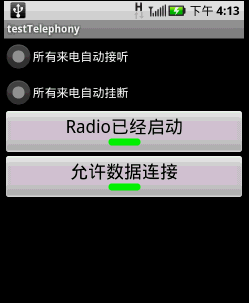前面文章介绍了如何使用JAVA的反射机制来调用蓝牙的隐藏api,本文继续来练习JAVA的反射机制,探秘TelephonyManager在Framework里包含却在SDK隐藏的
前面文章介绍了如何使用JAVA的反射机制来调用蓝牙的隐藏api,本文继续来练习JAVA的反射机制,探秘TelephonyManager在Framework里包含却在SDK隐藏的几项功能。
先来看一下本文程序运行的效果图,如下所示:

本文程序演示了以下功能:
1.所有来电自动接听;
2.所有来电自动挂断;
3.开启/关闭Radio;
4.开启/关闭数据连接(WAP or NET的连接)。
调用TelephonyManager的隐藏API是先参考Framework的/base/telephony/java/com/Android/internal/telephony/ITelephony.aidl,然后自己实现一个ITelephony.aidl,最后在TelephonyManager中通过反射机制实例化自定义的ITelephony,实例化之后就可以调用ITelephony里面的函数了。
本文程序需要在AndroidManifest.xml添加以下两行代码,以获得权限:
<uses-permission android:name="android.permission.CALL_PHONE" />
<uses-permission android:name="android.permission.MODIFY_PHONE_STATE" />
main.xml源码如下:
<?xml version="1.0" encoding="utf-8"?>
<LinearLayout xmlns:android="Http://schemas.android.com/apk/res/android"
android:orientation="vertical" android:layout_width="fill_parent"
android:layout_height="fill_parent">
<RadioGroup android:layout_height="wrap_content"
android:layout_width="fill_parent" android:id="@+id/rGrpSelect">
<RadioButton android:layout_height="wrap_content"
android:layout_width="fill_parent" android:id="@+id/rbtnAutoAccept"
android:text="所有来电自动接听"></RadioButton>
<RadioButton android:layout_height="wrap_content"
android:layout_width="fill_parent" android:id="@+id/rbtnAutoReject"
android:text="所有来电自动挂断"></RadioButton>
</RadioGroup>
<ToggleButton android:layout_height="wrap_content"
android:layout_width="fill_parent" android:id="@+id/tbtnRadiOSwitch"
android:textOn="Radio已经启动" android:textOff="Radio已经关闭"
android:textSize="24dip" android:textStyle="nORMal"></ToggleButton>
<ToggleButton android:layout_height="wrap_content"
android:layout_width="fill_parent" android:id="@+id/tbtnDataConn"
android:textSize="24dip" android:textStyle="normal" android:textOn="允许数据连接"
android:textOff="禁止数据连接"></ToggleButton>
</LinearLayout>
PhoneUtils.java是手机功能类,从TelephonyManager中实例化ITelephony并返回,源码如下:
package com.testTelephony;
import java.lang.reflect.Field;
import java.lang.reflect.Method;
import com.android.internal.telephony.ITelephony;
import android.telephony.TelephonyManager;
import android.util.Log;
public class PhoneUtils {
static public ITelephony getITelephony(TelephonyManager telMgr) throws Exception {
Method getITelephonyMethod = telMgr.getClass().getDeclaredMethod("getITelephony");
getITelephonyMethod.setAccessible(true);//私有化函数也能使用
return (ITelephony)getITelephonyMethod.invoke(telMgr);
}
static public void printAllInform(Class clsshow) {
try {
// 取得所有方法
Method[] hideMethod = clsShow.getDeclaredMethods();
int i = 0;
for (; i < hideMethod.length; i++) {
Log.e("method name", hideMethod[i].getName());
}
// 取得所有常量
Field[] allFields = clsShow.getFields();
for (i = 0; i < allFields.length; i++) {
Log.e("Field name", allFields[i].getName());
}
} catch (SecurityException e) {
// throw new RuntimeException(e.getMessage());
e.printStackTrace();
} catch (IllegalArgumentException e) {
// throw new RuntimeException(e.getMessage());
e.printStackTrace();
} catch (Exception e) {
// TODO Auto-generated catch block
e.printStackTrace();
}
}
}
testTelephony.java是主类,使用PhoneStateListener监听通话状态,以及实现上述4种电话控制功能,源码如下:
package com.testTelephony;
import android.app.Activity;
import android.os.Bundle;
import android.telephony.PhoneStateListener;
import android.telephony.TelephonyManager;
import android.util.Log;
import android.view.View;
import android.widget.RadioGroup;
import android.widget.ToggleButton;
public class testTelephony extends Activity {
RadioGroup rg;//来电操作单选框
ToggleButton tbtnRadioSwitch;//Radio开关
ToggleButton tbtnDataConn;//数据连接的开关
TelephonyManager telMgr;
CallStateListener stateListner;
int checkedId=0;
@Override
public void onCreate(Bundle savedInstanceState) {
super.onCreate(savedInstanceState);
setContentView(R.layout.main);
telMgr= (TelephonyManager)getSystemService(TELEPHONY_SERVICE);
telMgr.listen(new CallStateListener(), CallStateListener.LISTEN_CALL_STATE);
PhoneUtils.printAllInform(TelephonyManager.class);
rg = (RadioGroup)findViewById(R.id.rGrpSelect);
rg.setOnCheckedChangeListener(new CheckEvent());
tbtnRadioSwitch=(ToggleButton)this.findViewById(R.id.tbtnRadioSwitch);
tbtnRadioSwitch.setOnClickListener(new ClickEvent());
try {
tbtnRadioSwitch.setChecked(PhoneUtils.getITelephony(telMgr).isRadioOn());
} catch (Exception e) {
Log.e("error",e.getMessage());
}
tbtnDataConn=(ToggleButton)this.findViewById(R.id.tbtnDataConn);
tbtnDataConn.setOnClickListener(new ClickEvent());
try {
tbtnDataConn.setChecked(PhoneUtils.getITelephony(telMgr).isDataConnectivityPossible());
} catch (Exception e) {
Log.e("error",e.getMessage());
}
}
public class CheckEvent implements RadioGroup.OnCheckedChangeListener{
@Override
public void onCheckedChanged(RadioGroup group, int checkedId) {
testTelephony.this.checkedId=checkedId;
}
}
public class ClickEvent implements View.OnClickListener{
@Override
public void onClick(View v) {
if (v == tbtnRadioSwitch) {
try {
PhoneUtils.getITelephony(telMgr).setRadio(tbtnRadioSwitch.isChecked());
} catch (Exception e) {
Log.e("error", e.getMessage());
}
}
else if(v==tbtnDataConn){
try {
if(tbtnDataConn.isChecked())
PhoneUtils.getITelephony(telMgr).enableDataConnectivity();
else if(!tbtnDataConn.isChecked())
PhoneUtils.getITelephony(telMgr).disableDataConnectivity();
} catch (Exception e) {
Log.e("error", e.getMessage());
}
}
}
}
public class CallStateListener extends PhoneStateListener {
@Override
public void onCallStateChanged(int state, String incomingNumber) {
if(state==TelephonyManager.CALL_STATE_IDLE)//挂断
{
Log.e("IDLE",incomingNumber);
}
else if(state==TelephonyManager.CALL_STATE_OFFHOOK)//接听
{
Log.e("OFFHOOK",incomingNumber);
}
else if(state==TelephonyManager.CALL_STATE_RINGING)//来电
{
if(testTelephony.this.checkedId==R.id.rbtnAutoAccept)
{
try {
//需要<uses-permission android:name="android.permission.MODIFY_PHONE_STATE" />
PhoneUtils.getITelephony(telMgr).silenceRinger();//静铃
PhoneUtils.getITelephony(telMgr).answerRinginGCall();//自动接听
} catch (Exception e) {
Log.e("error",e.getMessage());
}
}
else if(testTelephony.this.checkedId==R.id.rbtnAutoReject)
{
try {
PhoneUtils.getITelephony(telMgr).endCall();//挂断
PhoneUtils.getITelephony(telMgr).cancelMissedCallsNotification();//取消未接显示
} catch (Exception e) {
Log.e("error",e.getMessage());
}
}
}
super.onCallStateChanged(state, incomingNumber);
}
}
}感兴趣的读者可以测试一下本文实例代码,希望能够对大家的Android项目开发有所帮助。
您可能感兴趣的文章:Android中TelephonyManager用法实例Android中TelephonyManager类的用法案例详解Android中TelephonyManager类的方法实例分析Android 应用更换皮肤实现方法安卓(Android)开发之统计App启动时间Android如何自定义按钮效果Android GPS详解及示例代码Android TelephonyManager详解及实现代码
--结束END--
本文标题: Android提高之TelephonyManager功能探秘
本文链接: https://lsjlt.com/news/27026.html(转载时请注明来源链接)
有问题或投稿请发送至: 邮箱/279061341@qq.com QQ/279061341
2024-01-21
2023-10-28
2023-10-28
2023-10-27
2023-10-27
2023-10-27
2023-10-27
回答
回答
回答
回答
回答
回答
回答
回答
回答
回答
0